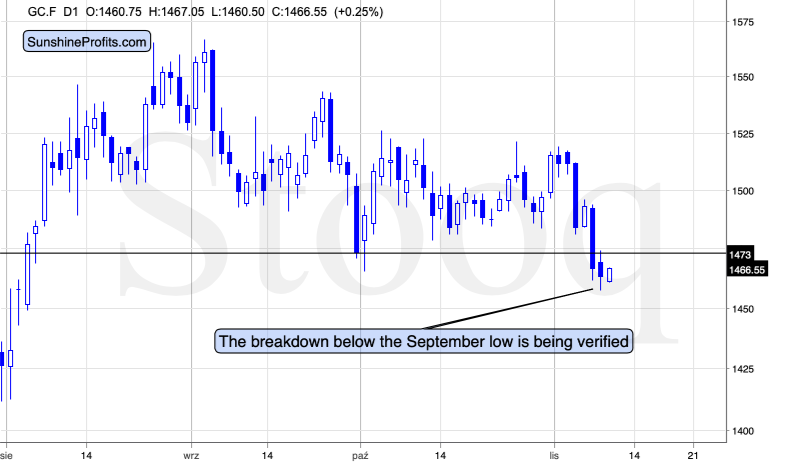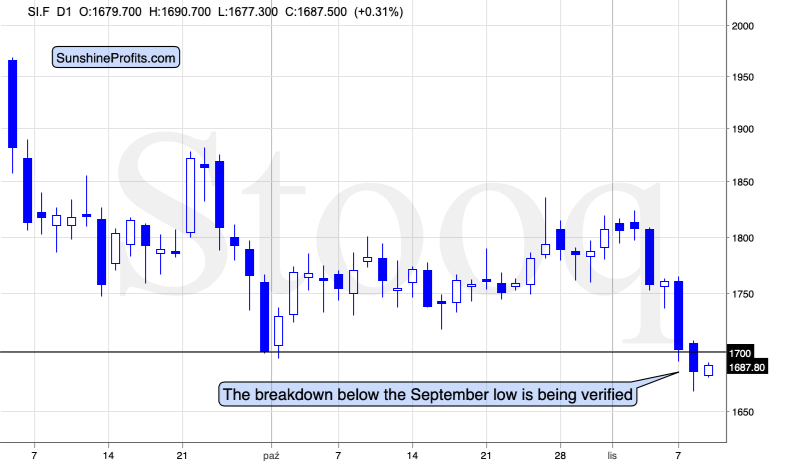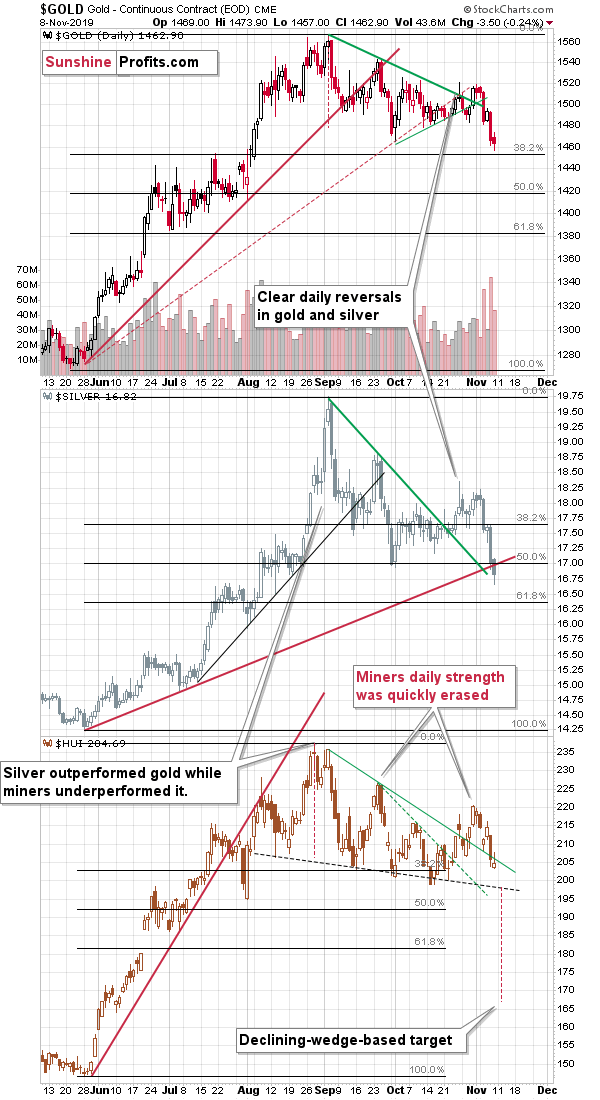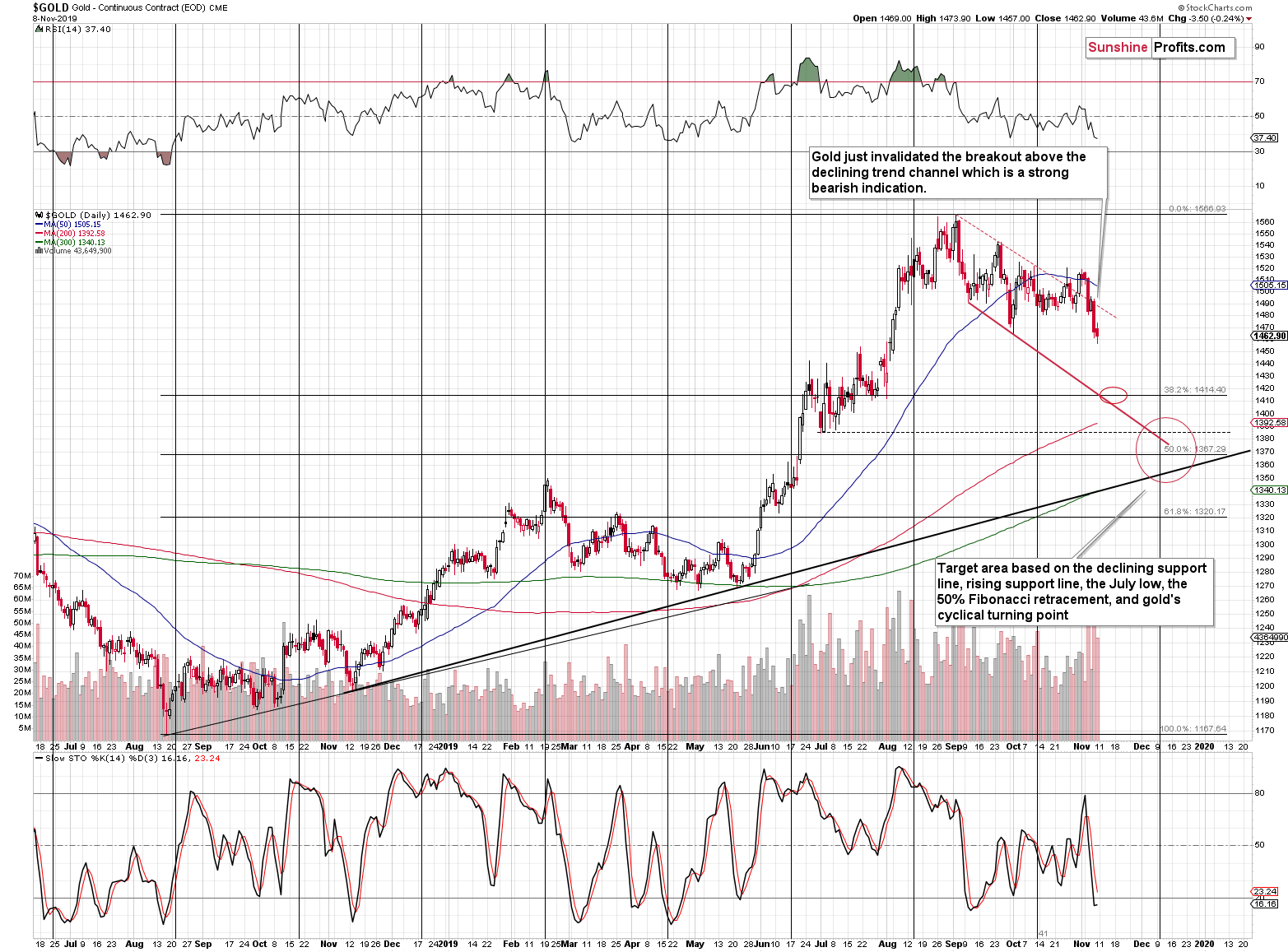Briefly: in our opinion, full (250% of the regular size of the position) speculative short position in gold, silver, and mining stocks is justified from the risk/reward point of view at the moment of publishing this Alert.
Gold plunged last week just as we've been describing it. We wrote that the triple (in gold, silver, and miners) vertex-based reversal after a short-term rally was a very bearish development and indeed, that was the top after which the PMs plunged. Both key precious metals ended the previous week significantly lower and - most importantly - they closed below their lowest closing prices of September. This means one thing: major breakdowns. And major breakdowns mean major declines just around the corner.
- Ok, if that's the case, then why are gold and silver moving higher today?
No market can move up or down in a straight line without periodic corrections or breathers (particularly short corrections). It seems that we're seeing one in gold and one in silver. Of course, such corrections can turn into big rallies, but nothing that we saw so far today indicates that this would be the case right now.
Why?
The Perspective of Gold's Rally
Because the key support lines remain intact. Both: gold and silver moved a bit higher today, but they didn't even touch the levels of their September lows, let alone break above them.
On Thursday, gold declined below the lowest closing price that we saw since early August -with the most visible sign that something major happened being that it closed below the September low in terms of closing prices. The key thing happened on Friday, though.
Actually, the most important is what didn't happen. Gold didn't invalidate the above-mentioned breakdown. It moved lower just a bit, but - after an intraday attempt to rally - it closed once again below the lowest closing price of September. Some may report gold's breakdown as verified, but based on our experience in the precious metals market, it's best to wait for three subsequent closes before saying that a breakout or breakdown is truly confirmed. So, gold's breakdown was not invalidated, and it's almost confirmed right now.
At the moment of writing these words, gold is trading about $5 below the September low, which means that the breakdown was not invalidated. Even if gold moves temporarily above it, but still closes at or below the September low, the breakdown will not be invalidated - after all, the breakdown is based on the closing prices, so it's confirmation or invalidation will also take place in these terms.
This means that the September low is likely to provide short-term resistance and if this resistance holds (which is likely), it will open the way for further declines - likely to one of our near-term price targets for the yellow metal.
Silver's Turn Now
And what about silver? It broke and closed below the lowest closing prices of September on Friday, so today is the second trading day when it's trading below it. The implications of today's close will not be as severe as they will be in case of gold's close, but the September low is still likely to provide important short-term resistance.
Let's keep in mind that silver did more than just break below the lowest closing price of September.
Silver also broke below the rising red support line and the 50% Fibonacci retracement level. Technically, silver's breakdown was even more important than the one in gold. The fact that the white metal managed to close the week below the combination of three support levels is bearish, but it will become much more so only after it's verified.
- So, isn't it best to wait for the breakdown in silver to be confirmed, before aiming to profit on the decline?
That's one way to do it, and if anyone wants to take this route - sure, it's their capital. We think that having a position open right now is better from the risk to reward point of view because of the almost-confirmed breakdown in gold, and because of multiple signs that we have covered in our previous analyses and that we can't discuss on each day - there's simply not enough space and time to again go through all the bearish factors that remain in place right now.
It is usually the case that three consecutive closes below a certain level are necessary for the market to verify the breakdown, but given how strongly correlated gold and silver are, the odds are that a slide in gold will trigger a powerful slide in silver as well. And gold's plunge could start any day, hour, or minute.
As far as target prices for gold are concerned, our previous comments remain up-to-date:
Gold's Target Prices
If gold slides very sharply, then it may be the case that the move is unsustainable even on a short-term basis.
That's right - despite myriads of bearish factors that remain in place, gold could still bounce if the price gets too low too fast. Yesterday, gold showed that it can move substantially lower with little help from the USDX. So, what's likely to happen if gold actually gets a sizable push from the USD? It would likely plunge.
The sharper the decline, the less sustainable it usually becomes, especially in the early part of the bigger downswing, and that's where gold is right now. So, while the $1,360 - $1,390 area is still likely to trigger a more visible reversal, if gold declines very sharply right away (next week or even today), then we might get a quick rebound sooner.
At what level could gold reverse in this case? At about $1,410 - $1,420. This is where three important support levels coincide:
- the declining support line
- the 38.2% Fibonacci retracement level
- the early August low that started the sharp decline to the final top.
If gold moves there and at the same time silver and mining stocks move to important support levels of their own, and mining stocks show strength, we might decide to temporarily exit the short positions and perhaps enter long positions.
We are not adjusting the binding profit-take levels for this trade, because whether or not we choose to change anything with gold at $1,420 or so depends also on how silver, miners, and USDX perform at that time (also relative to each other). We are keeping our eyes open for the quick-profit opportunity and we'll keep you informed. The above is simply an early heads-up that something like that might happen in the near future.
Naturally, the other key bearish factors for the medium term remain intact as well.
Key Factors to Keep in Mind
Critical factors:
- The USD Index broke above the very long-term resistance line and verified the breakout above it. Its huge upswing is already underway.
- The USD's long-term upswing is an extremely important and bearish factor for gold. There were only two similar cases in the past few decades, when USD Index was starting profound, long-term bull markets, and they were both accompanied by huge declines in gold and the rest of the precious metals market
- Out of these two similar cases, only one is very similar - the case when gold topped in February 1996. The similarity extends beyond gold's about a yearly delay in reaction to the USD's rally. Also the shape of gold price moves prior to the 1996 high and what we saw in the last couple of years is very similar, which confirm the analysis of the gold-USD link and the above-mentioned implications of USD Index's long-term breakout.
- The similarity between now and 1996 extends to silver and mining stocks - in other words, it goes beyond USD, gold-USD link, and gold itself. The white metal and its miners appear to be in a similar position as well, and the implications are particularly bearish for the miners. After their 1996 top, they erased more than 2/3rds of their prices.
- Many investors got excited by the gold-is-soaring theme in the last few months, but looking beyond the short-term moves, reveals that most of the precious metals sector didn't show substantial strength that would be really visible from the long-term perspective. Gold doesn't appear to be starting a new bull market here, but rather to be an exception from the rule.
- Gold stocks appear to be repeating their performance from 20 years ago, which means that a bottom in the entire precious metals sector is quite likely to form at much lower prices, in about a year
Very important, but not as critical factors:
- Long-term technical signs for silver, i.a. the analogy in terms of price to what we saw in 2008, shows that silver could slide even below $10.
- Silver's very long-term cycles point to a major reversal taking place right now and since the most recent move was up, the implications are bearish (this is also silver's technical sign, but it's so important that it deserves its own point)
- Long-term technical signs for gold stocks point to this not being a new gold bull market beginning. Among others, it's their long-term underperformance relative to gold that hint this is rather a corrective upswing within a bear market that is not over yet.
- Record-breaking weekly volume in gold is a strong sign pointing to lower gold prices
Important factors:
- Extreme volume reading in the SIL ETF (proxy for silver stocks) is an effective indication that lower values of silver miners are to be expected
- Silver's short-term outperformance of gold, and gold stocks' short-term underperformance of gold both confirm that the precious metals sector is topping here
- Gold topped almost right at its cyclical turning point, which makes the trend reversal more likely
- Copper broke below its head-and-shoulders pattern and confirmed the breakdown. The last time we saw something similar was in April 2013, when the entire precious metals sector was on the verge of plunging lower.
Moreover, please note that while there may be a recession threat, it doesn't mean that gold has to rally immediately. Both: recession and gold's multi-year rally could be many months away - comparing what happened to bond yields in the 90s confirms that.
Summary
Summing up, the outlook for the precious metals sector remains very bearish for the following weeks and months.
The profits from the short position in gold, silver and mining stocks are likely to be legendary, but the difficult part is not to miss the decline, which is why we're rather reluctant to exit the short position very often. Still, since no market moves up and down in a straight line, it makes sense to time the moves that appear to have favorable risk to reward ratios. Based on the information that we have available right now, it seems that the next opportunity to take profits from the short positions and perhaps enter long positions will take place next month, quite likely close to $1,400 in gold. However, if we see a good chance for a quick and sizable rebound even before that, we might adjust our trading positions accordingly.
As always, we'll keep you - our subscribers - informed.
To summarize:
Trading capital (supplementary part of the portfolio; our opinion): Full speculative short position (250% of the full position) in gold, silver, and mining stocks are justified from the risk/reward perspective with the following stop-loss orders and binding exit profit-take price levels:
- Gold: profit-take exit price: $1,391; stop-loss: $1,573; initial target price for the DGLD ETN: $36.37; stop-loss for the DGLD ETN: $25.44
- Silver: profit-take exit price: $15.11; stop-loss: $19.06; initial target price for the DSLV ETN: $24.88; stop-loss for the DSLV ETN: $14.07
- Mining stocks (price levels for the GDX ETF): profit-take exit price: $23.21; stop-loss: $30.11; initial target price for the DUST ETF: $14.69; stop-loss for the DUST ETF $6.08
In case one wants to bet on junior mining stocks' prices, here are the stop-loss details and target prices:
- GDXJ ETF: profit-take exit price: $30.32; stop-loss: $41.22
- JDST ETF: profit-take exit price: $35.88 stop-loss: $12.46
Long-term capital (core part of the portfolio; our opinion): No positions (in other words: cash)
Insurance capital (core part of the portfolio; our opinion): Full position
Whether you already subscribed or not, we encourage you to find out how to make the most of our alerts and read our replies to the most common alert-and-gold-trading-related-questions.
Please note that the in the trading section we describe the situation for the day that the alert is posted. In other words, it we are writing about a speculative position, it means that it is up-to-date on the day it was posted. We are also featuring the initial target prices, so that you can decide whether keeping a position on a given day is something that is in tune with your approach (some moves are too small for medium-term traders and some might appear too big for day-traders).
Plus, you might want to read why our stop-loss orders are usually relatively far from the current price.
Please note that a full position doesn't mean using all of the capital for a given trade. You will find details on our thoughts on gold portfolio structuring in the Key Insights section on our website.
As a reminder - "initial target price" means exactly that - an "initial" one, it's not a price level at which we suggest closing positions. If this becomes the case (like it did in the previous trade) we will refer to these levels as levels of exit orders (exactly as we've done previously). Stop-loss levels, however, are naturally not "initial", but something that, in our opinion, might be entered as an order.
Since it is impossible to synchronize target prices and stop-loss levels for all the ETFs and ETNs with the main markets that we provide these levels for (gold, silver and mining stocks - the GDX ETF), the stop-loss levels and target prices for other ETNs and ETF (among other: UGLD, DGLD, USLV, DSLV, NUGT, DUST, JNUG, JDST) are provided as supplementary, and not as "final". This means that if a stop-loss or a target level is reached for any of the "additional instruments" (DGLD for instance), but not for the "main instrument" (gold in this case), we will view positions in both gold and DGLD as still open and the stop-loss for DGLD would have to be moved lower. On the other hand, if gold moves to a stop-loss level but DGLD doesn't, then we will view both positions (in gold and DGLD) as closed. In other words, since it's not possible to be 100% certain that each related instrument moves to a given level when the underlying instrument does, we can't provide levels that would be binding. The levels that we do provide are our best estimate of the levels that will correspond to the levels in the underlying assets, but it will be the underlying assets that one will need to focus on regarding the signs pointing to closing a given position or keeping it open. We might adjust the levels in the "additional instruments" without adjusting the levels in the "main instruments", which will simply mean that we have improved our estimation of these levels, not that we changed our outlook on the markets. We are already working on a tool that would update these levels on a daily basis for the most popular ETFs, ETNs and individual mining stocks.
Our preferred ways to invest in and to trade gold along with the reasoning can be found in the how to buy gold section. Additionally, our preferred ETFs and ETNs can be found in our Gold & Silver ETF Ranking.
As a reminder, Gold & Silver Trading Alerts are posted before or on each trading day (we usually post them before the opening bell, but we don't promise doing that each day). If there's anything urgent, we will send you an additional small alert before posting the main one.
Thank you.
Sincerely,
Przemyslaw Radomski, CFA
Editor-in-chief, Gold & Silver Fund Manager







